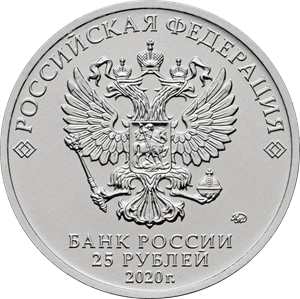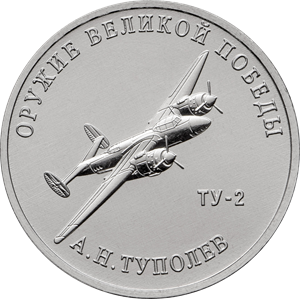Weapons Designer Andrei Tupolev
Obverse
in the centre there is a relief image of the National Coat of Arms of the Russian Federation and over it a semicircular inscription along the rim: "РОССИЙСКАЯ ФЕДЕРАЦИЯ" (RUSSIAN FEDERATION) framed by doubled rhombuses on both sides, under the emblem, in three lines, there is an inscription: "БАНК РОССИИ" (BANK OF RUSSIA), the coin’s par value "25 РУБЛЕЙ" (25 RUBLES), and the year of issue "2020 г." (2020), and on the right there is a mint trade mark.
Reverse
a relief image of the Tu-2 frontline bomber aircraft and the inscription‘ТУ-2’ (TU-2) on the right; along the rim there are the inscriptions ‘ОРУЖИЕ ВЕЛИКОЙ ПОБЕДЫ’ (WEAPONS OF THE GREAT VICTORY) at the top and ‘А.Н. ТУПОЛЕВ’ (ANDREI TUPOLEV) at the bottom.
Authors
Designers: E.V. Kramskaya (obverse), O.G. Shepel (reverse).
Sculptors: A.A. Dolgopolova (obverse), computer simulation (reverse).
Mint: Moscow Mint (ММД).
Edge: 180 corrugations.
Discover more
Andrei Nikolayevich Tupolev (1888–1972) was a Soviet aircraft designer and the creator of the Tu-2 front-line bomber aircraft, which was deployed by the Soviet military in 1942.
Tupolev worked on his invention at a secret research and development facility overseen by the NKVD, following his arrest for alleged espionage. Tupolev was given an early release in 1941, and set to work on improving his aircraft, which would eventually prove to be one of the best planes deployed during the Great Patriotic War and, together with the Pe-2 dive bomber, would form the core of the Soviet army’s bomber aviation. The Tu-2 had several significant advantages over the Pe-2; however, it simply had no time to become the main bomber of the Soviet air forces: the USSR’s aircraft industry was under immense strain at the time, and it was not until 1943 that the mass production of the Tu-2 could begin properly. The design team headed by Tupolev used that time to work thoroughly on simplifying both the aircraft’s structure and its assembly process, in addition to decreasing its weight, improving its speed, and adding better defensive weapons.
Their efforts resulted in the creation of the most efficient Soviet front-line bomber, which rightfully earned its reputation thanks to its excellent flight and combat performance, including reliability, resilience, extraordinary speed and range, ease of operation, high manoeuvring capability and durability in combat, and impressive offensive and defensive weapons.


